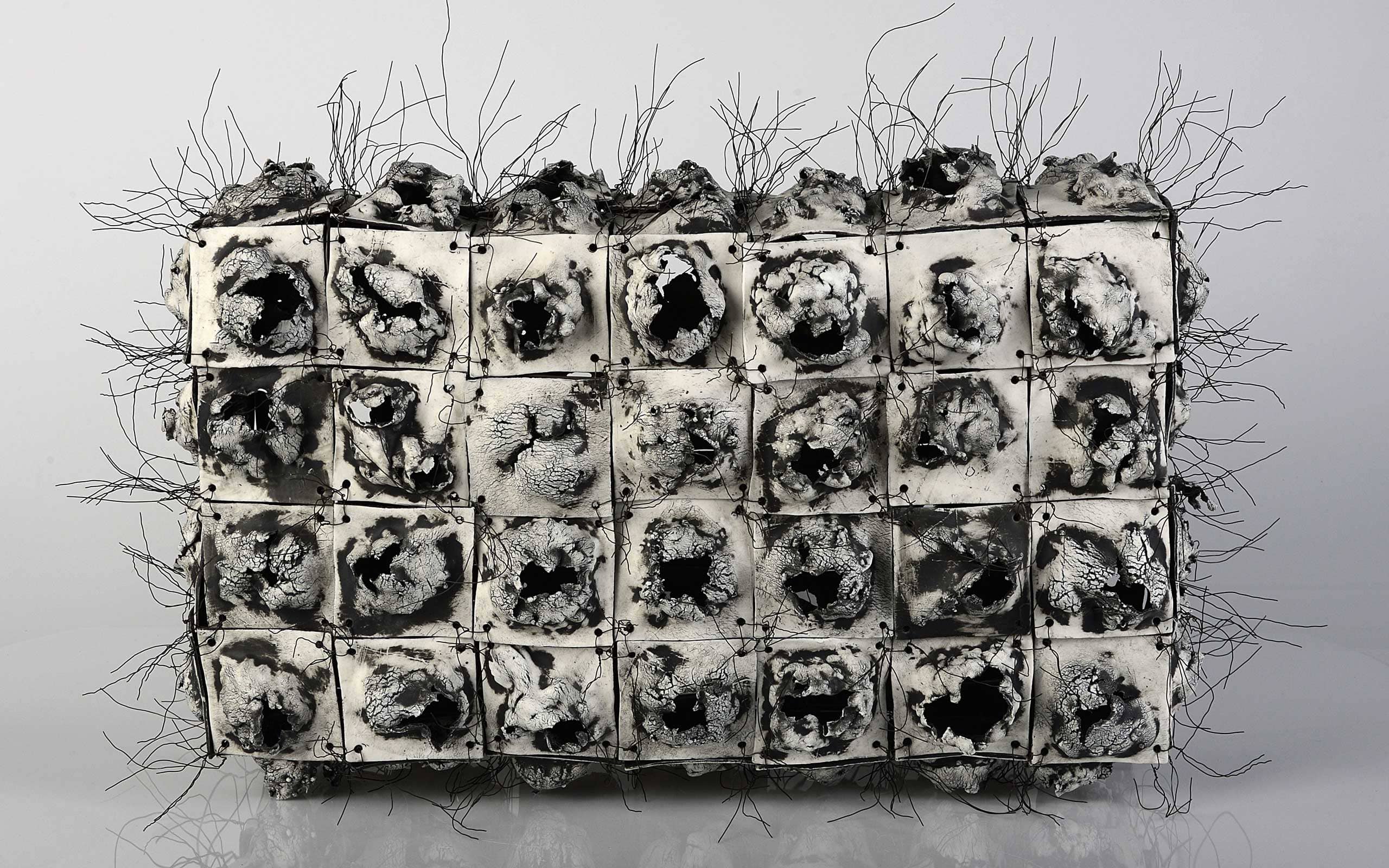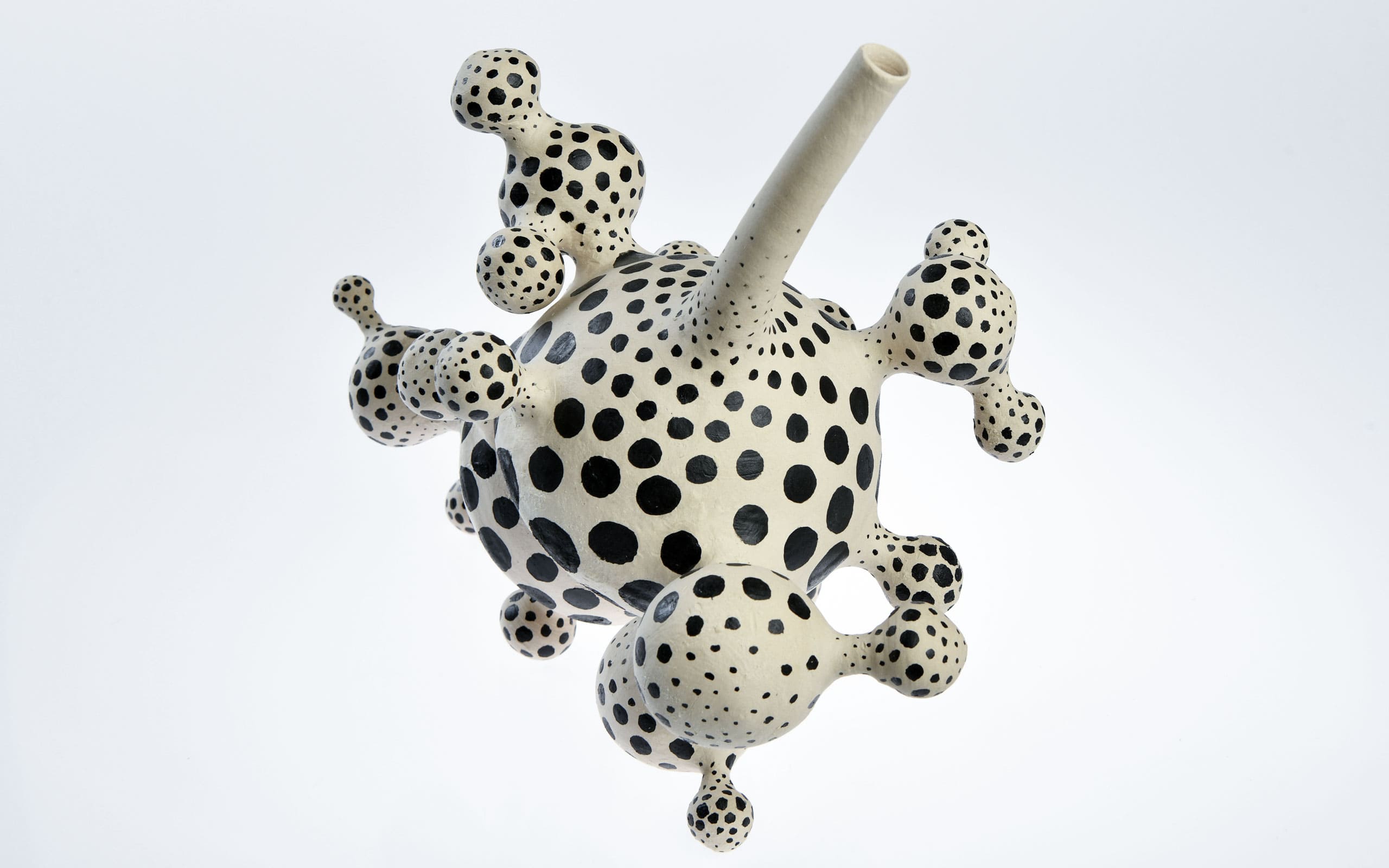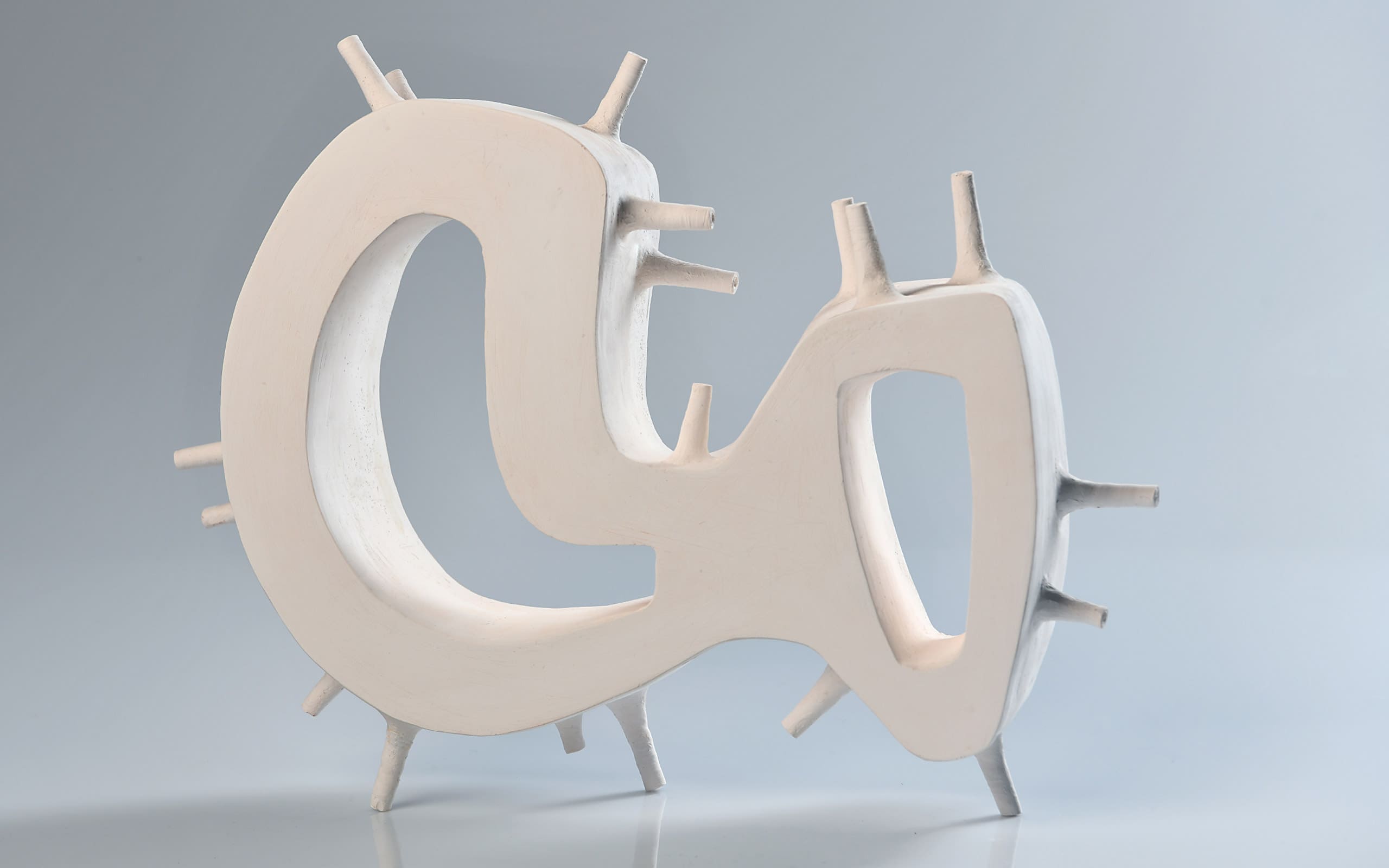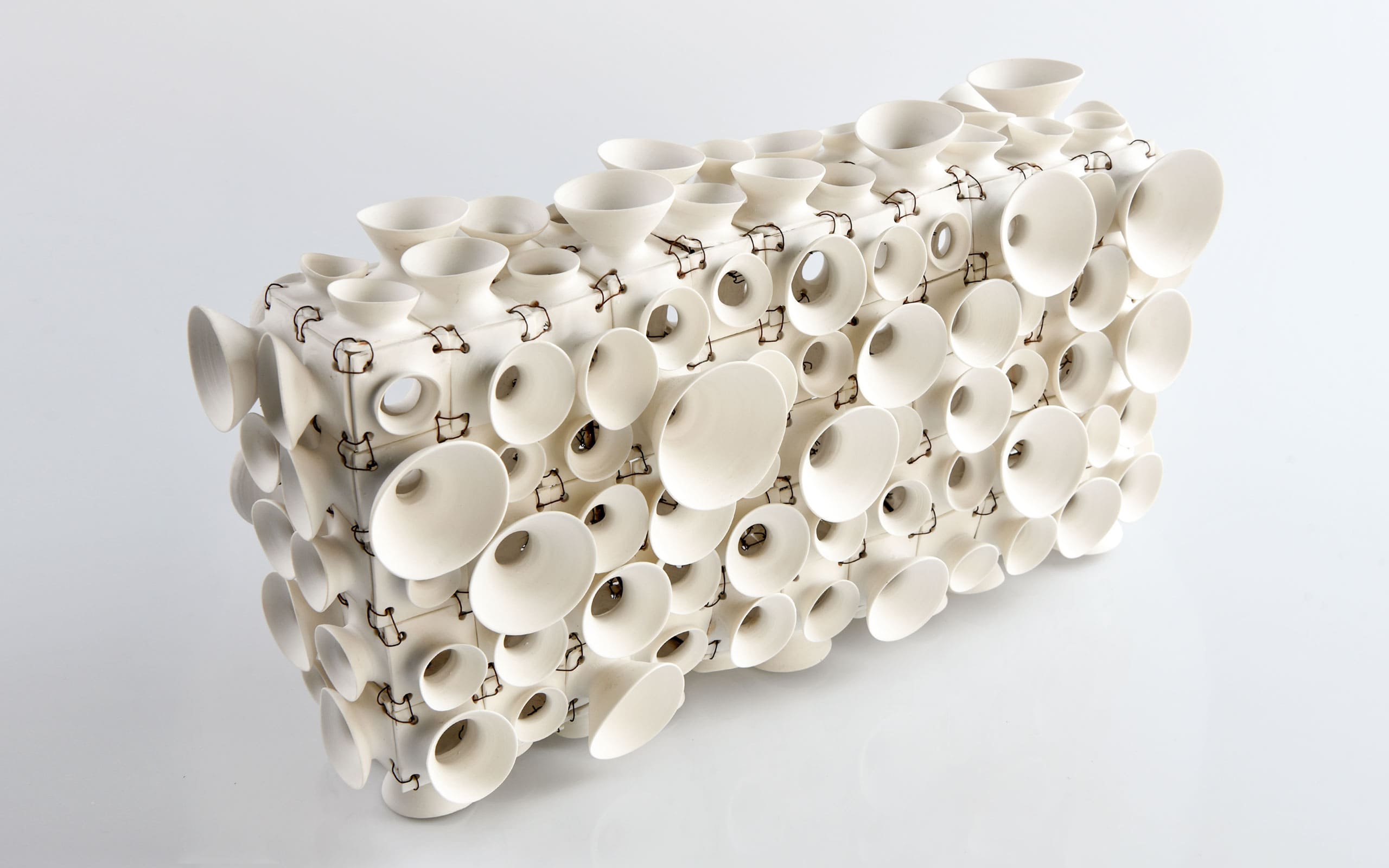Tales made of porcelain
Tales made of porcelain
Tales made of porcelain
URSULA COMMANDFEUR
Tales made of porcelain
URSULA COMMANDEUR
Tales made of porcelain
There has always been something mysterious about white gold, as porcelain is admiringly called. Ever since it was brought to Europe from faraway China by adventurous means against an export ban, ever since the legendary travelogues of Marco Polo. And in Europe, craftsmen, artists and alchemists sought to look behind the mystery, to decipher the composition of this fine material; above all, Johann Friedrich Böttger at the court of Augustus the Strong in Dresden during the Baroque period and head of the manufactory in Meissen.
This extraordinary esteem was, and still is, especially for the fine, delicate light ivory-coloured bisque porcelain. It has a unique impression, which becomes vivid with its light surface and its graceful effect as a volume, with a filigree appearance even with strong forms. The ceramist Ursula Commandeur stands in this valuable tradition with her peculiar art objects. The artist shows new works that are even further, even more vividly moulded into the tension between delicacy and hardness. She creates unique structures full of grace and character.
Her works of art are so graceful that they invite you to caress them. They evoke empathy, appearing so delicate and soft and warm, but are firm and cold and also display hard, almost industrial-looking forms. The fine wires often seem like fine feelers, sometimes they even seem to float slowly as if in a trance. Then again, the form stands clear and pure before the eye, sober and matter-of-fact.
Ursula Commandeur's art objects then seem poetic precisely in their simplicity and straightforwardness. Funnels, conical shapes, round recesses are combined additively to form larger units. The individuality of the single form competes with serial repetition. What can be formed from a lump? The artist is a creator: almost biblical in the work that always begins fundamentally in building up, because communication means "being in flux". Soft materials emphasise this movement and changeability. Porcelain is soft at first, but after firing it becomes hard, but retains the impression of pliability.
There is an inherent charm in the fact that the work of art entices us to touch it, to touch it, but this is refused. So the idea of completion must come to the rescue, offer proof of satisfaction. The sense of touch is additionally stimulated in Ursula Commandeur's objects by their sensitive and careful elaboration.
The lovers argue about it in their affection - and they can rekindle it every time, which is more beautiful, the idea or the completion of satisfaction. Each side has good arguments in its favour and emphasises the primacy of the present or the future. But art combines both possibilities. Current free art with the material porcelain, which is more in the realm of applied art, represents for the artist, who is also familiar with application-oriented elaboration, a release of her imagination and her fabulation full of ideas.
Ursula Commandeur's art objects testify to a joy and an obsession, in a positive sense, that communicates itself to the viewer. Their direct effect, however, does not completely decipher the mysterious, so their permanent stimulation and delicate enchantment remain in motion.
MICHAEL KADE
There has always been something mysterious about white gold, as porcelain is admiringly called. Ever since it was brought to Europe from faraway China by adventurous means against an export ban, ever since the legendary travelogues of Marco Polo. And in Europe, craftsmen, artists and alchemists sought to look behind the mystery, to decipher the composition of this fine material; above all, Johann Friedrich Böttger at the court of Augustus the Strong in Dresden during the Baroque period and head of the manufactory in Meissen.
This extraordinary esteem was, and still is, especially for the fine, delicate light ivory-coloured bisque porcelain. It has a unique impression, which becomes vivid with its light surface and its graceful effect as a volume, with a filigree appearance even with strong forms. The ceramist Ursula Commandeur stands in this valuable tradition with her peculiar art objects. The artist shows new works that are even further, even more vividly moulded into the tension between delicacy and hardness. She creates unique structures full of grace and character.
Her works of art are so graceful that they invite you to caress them. They evoke empathy, appearing so delicate and soft and warm, but are firm and cold and also display hard, almost industrial-looking forms. The fine wires often seem like fine feelers, sometimes they even seem to float slowly as if in a trance. Then again, the form stands clear and pure before the eye, sober and matter-of-fact.
Ursula Commandeur's art objects then seem poetic precisely in their simplicity and straightforwardness. Funnels, conical shapes, round recesses are combined additively to form larger units. The individuality of the single form competes with serial repetition. What can be formed from a lump? The artist is a creator: almost biblical in the work that always begins fundamentally in building up, because communication means "being in flux". Soft materials emphasise this movement and changeability. Porcelain is soft at first, but after firing it becomes hard, but retains the impression of pliability.
There is an inherent charm in the fact that the work of art entices us to touch it, to touch it, but this is refused. So the idea of completion must come to the rescue, offer proof of satisfaction. The sense of touch is additionally stimulated in Ursula Commandeur's objects by their sensitive and careful elaboration.
The lovers argue about it in their affection - and they can rekindle it every time, which is more beautiful, the idea or the completion of satisfaction. Each side has good arguments in its favour and emphasises the primacy of the present or the future. But art combines both possibilities. Current free art with the material porcelain, which is more in the realm of applied art, represents for the artist, who is also familiar with application-oriented elaboration, a release of her imagination and her fabulation full of ideas.
Ursula Commandeur's art objects testify to a joy and an obsession, in a positive sense, that communicates itself to the viewer. Their direct effect, however, does not completely decipher the mysterious, so their permanent stimulation and delicate enchantment remain in motion.
MICHAEL KADE
There has always been something mysterious about white gold, as porcelain is admiringly called. Ever since it was brought to Europe from faraway China by adventurous means against an export ban, ever since the legendary travelogues of Marco Polo. And in Europe, craftsmen, artists and alchemists sought to look behind the mystery, to decipher the composition of this fine material; above all, Johann Friedrich Böttger at the court of Augustus the Strong in Dresden during the Baroque period and head of the manufactory in Meissen.
This extraordinary esteem was, and still is, especially for the fine, delicate light ivory-coloured bisque porcelain. It has a unique impression, which becomes vivid with its light surface and its graceful effect as a volume, with a filigree appearance even with strong forms. The ceramist Ursula Commandeur stands in this valuable tradition with her peculiar art objects. The artist shows new works that are even further, even more vividly moulded into the tension between delicacy and hardness. She creates unique structures full of grace and character.
Her works of art are so graceful that they invite you to caress them. They evoke empathy, appearing so delicate and soft and warm, but are firm and cold and also display hard, almost industrial-looking forms. The fine wires often seem like fine feelers, sometimes they even seem to float slowly as if in a trance. Then again, the form stands clear and pure before the eye, sober and matter-of-fact.
Ursula Commandeur's art objects then seem poetic precisely in their simplicity and straightforwardness. Funnels, conical shapes, round recesses are combined additively to form larger units. The individuality of the single form competes with serial repetition. What can be formed from a lump? The artist is a creator: almost biblical in the work that always begins fundamentally in building up, because communication means "being in flux". Soft materials emphasise this movement and changeability. Porcelain is soft at first, but after firing it becomes hard, but retains the impression of pliability.
There is an inherent charm in the fact that the work of art entices us to touch it, to touch it, but this is refused. So the idea of completion must come to the rescue, offer proof of satisfaction. The sense of touch is additionally stimulated in Ursula Commandeur's objects by their sensitive and careful elaboration.
The lovers argue about it in their affection - and they can rekindle it every time, which is more beautiful, the idea or the completion of satisfaction. Each side has good arguments in its favour and emphasises the primacy of the present or the future. But art combines both possibilities. Current free art with the material porcelain, which is more in the realm of applied art, represents for the artist, who is also familiar with application-oriented elaboration, a release of her imagination and her fabulation full of ideas.
Ursula Commandeur's art objects testify to a joy and an obsession, in a positive sense, that communicates itself to the viewer. Their direct effect, however, does not completely decipher the mysterious, so their permanent stimulation and delicate enchantment remain in motion.
MICHAEL KADE
There has always been something mysterious about white gold, as porcelain is admiringly called. Ever since it was brought to Europe from faraway China by adventurous means against an export ban, ever since the legendary travelogues of Marco Polo. And in Europe, craftsmen, artists and alchemists sought to look behind the mystery, to decipher the composition of this fine material; above all, Johann Friedrich Böttger at the court of Augustus the Strong in Dresden during the Baroque period and head of the manufactory in Meissen.
This extraordinary esteem was, and still is, especially for the fine, delicate light ivory-coloured bisque porcelain. It has a unique impression, which becomes vivid with its light surface and its graceful effect as a volume, with a filigree appearance even with strong forms. The ceramist Ursula Commandeur stands in this valuable tradition with her peculiar art objects. The artist shows new works that are even further, even more vividly moulded into the tension between delicacy and hardness. She creates unique structures full of grace and character.
Her works of art are so graceful that they invite you to caress them. They evoke empathy, appearing so delicate and soft and warm, but are firm and cold and also display hard, almost industrial-looking forms. The fine wires often seem like fine feelers, sometimes they even seem to float slowly as if in a trance. Then again, the form stands clear and pure before the eye, sober and matter-of-fact.
Ursula Commandeur's art objects then seem poetic precisely in their simplicity and straightforwardness. Funnels, conical shapes, round recesses are combined additively to form larger units. The individuality of the single form competes with serial repetition. What can be formed from a lump? The artist is a creator: almost biblical in the work that always begins fundamentally in building up, because communication means "being in flux". Soft materials emphasise this movement and changeability. Porcelain is soft at first, but after firing it becomes hard, but retains the impression of pliability.
There is an inherent charm in the fact that the work of art entices us to touch it, to touch it, but this is refused. So the idea of completion must come to the rescue, offer proof of satisfaction. The sense of touch is additionally stimulated in Ursula Commandeur's objects by their sensitive and careful elaboration.
The lovers argue about it in their affection - and they can rekindle it every time, which is more beautiful, the idea or the completion of satisfaction. Each side has good arguments in its favour and emphasises the primacy of the present or the future. But art combines both possibilities. Current free art with the material porcelain, which is more in the realm of applied art, represents for the artist, who is also familiar with application-oriented elaboration, a release of her imagination and her fabulation full of ideas.
Ursula Commandeur's art objects testify to a joy and an obsession, in a positive sense, that communicates itself to the viewer. Their direct effect, however, does not completely decipher the mysterious, so their permanent stimulation and delicate enchantment remain in motion.
MICHAEL KADE
There has always been something mysterious about white gold, as porcelain is admiringly called. Ever since it was brought to Europe from faraway China by adventurous means against an export ban, ever since the legendary travelogues of Marco Polo. And in Europe, craftsmen, artists and alchemists sought to look behind the mystery, to decipher the composition of this fine material; above all, Johann Friedrich Böttger at the court of Augustus the Strong in Dresden during the Baroque period and head of the manufactory in Meissen.
This extraordinary esteem was, and still is, especially for the fine, delicate light ivory-coloured bisque porcelain. It has a unique impression, which becomes vivid with its light surface and its graceful effect as a volume, with a filigree appearance even with strong forms. The ceramist Ursula Commandeur stands in this valuable tradition with her peculiar art objects. The artist shows new works that are even further, even more vividly moulded into the tension between delicacy and hardness. She creates unique structures full of grace and character.
Her works of art are so graceful that they invite you to caress them. They evoke empathy, appearing so delicate and soft and warm, but are firm and cold and also display hard, almost industrial-looking forms. The fine wires often seem like fine feelers, sometimes they even seem to float slowly as if in a trance. Then again, the form stands clear and pure before the eye, sober and matter-of-fact.
Ursula Commandeur's art objects then seem poetic precisely in their simplicity and straightforwardness. Funnels, conical shapes, round recesses are combined additively to form larger units. The individuality of the single form competes with serial repetition. What can be formed from a lump? The artist is a creator: almost biblical in the work that always begins fundamentally in building up, because communication means "being in flux". Soft materials emphasise this movement and changeability. Porcelain is soft at first, but after firing it becomes hard, but retains the impression of pliability.
There is an inherent charm in the fact that the work of art entices us to touch it, to touch it, but this is refused. So the idea of completion must come to the rescue, offer proof of satisfaction. The sense of touch is additionally stimulated in Ursula Commandeur's objects by their sensitive and careful elaboration.
The lovers argue about it in their affection - and they can rekindle it every time, which is more beautiful, the idea or the completion of satisfaction. Each side has good arguments in its favour and emphasises the primacy of the present or the future. But art combines both possibilities. Current free art with the material porcelain, which is more in the realm of applied art, represents for the artist, who is also familiar with application-oriented elaboration, a release of her imagination and her fabulation full of ideas.
Ursula Commandeur's art objects testify to a joy and an obsession, in a positive sense, that communicates itself to the viewer. Their direct effect, however, does not completely decipher the mysterious, so their permanent stimulation and delicate enchantment remain in motion.
MICHAEL KADE
Do you have any questions or
are you interested in an art object?
+49 171 9 62 67 58
ucommandeur@t-online.de
Do you have any questions or
are you interested in an art object?
+49 171 9 62 67 58 ucommandeur@t-online.de
Do you have any questions or are you interested in an art object?
+49 171 9 62 67 58
ucommandeur@t-online.de
Do you have any questions or are you interested in an art object?
+49 171 9 62 67 58
ucommandeur@t-online.de
Do you have any questions or are you interested in an art object?
+49 171 9 62 67 58
ucommandeur@t-online.de



